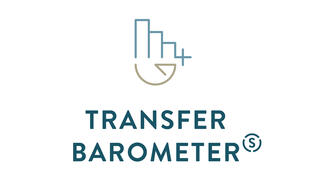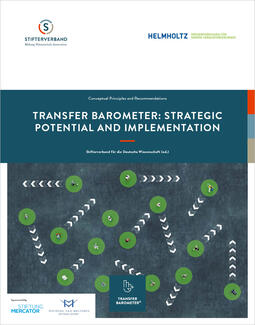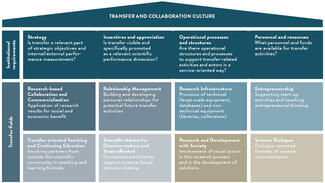
Transfer Barometer: Strategic Potential and Implementation
Conceptual Principles and Recommendations

The Transfer Barometer questions, expands and refines existing indicators for business- and technology-related transfer and offers suggestions for possible standardisation. In addition, the Transfer Barometer broadens the perspective on transfer and develops new sets of indicators to convey an understanding of transfer not limited to business- and technology-related transfer. The indicators were developed in collaboration with five selected universities and six Helmholtz Centres with different transfer profiles and field-tested at the institutions.
The indicators of the Transfer Barometer are not to be understood as conclusive. Rather, the aim is to adapt the proposed standard set to one’s own needs and to expand it. The aim of the Transfer Barometer is to create transparency and visibility of transfer activities at scientific institutions and to offer concrete starting points for internal management.
The experiences gathered in the course of the trial of the Transfer Barometer show that the recording involves noticeable survey effort. This is primarily due to the large number and variety of possible transfer activities, which are often decentralised and carried out by different actors and organisational units. In addition, especially in transfer areas not related to business and technology, there are still no well-established processes, structures and survey routines for collecting information at the source. With regard to the final determination of the indicators, the focus was on a high informative value combined with basic feasibility and acceptable survey effort.
This guide shows how the operational recording and capturing of transfer at scientific institutions can be accomplished with the help of the Transfer Barometer. It presents the conceptual basis and added value of the Transfer Barometer and provides guidance on the practical implementation. It focuses on findings and experiences across transfer fields as well as on concrete methodological recommendations.
The explanations are supplemented by a recording manual with a catalogue of indicators featuring a detailed presentation of all indicator sets and transferfield-specific survey information. This provides interested parties with a practical handbook for the capturing of their transfer activities. It offers field-proven knowledge as well as suggestions and guidance for operational implementation. The handout can serve to sensitise, motivate and support scientific institutions that would like to expand their transfer activities as part of their scientific performance.
THE PROJECT TRANSFER BAROMETER
- Transfer is increasingly relevant to the institutional development of universities and non-university research institutions.
- The transfer of knowledge and technology differs between universities and nonuniversity research institutions.
- The main challenge is to capture, record, categorise and transparently present achievements in knowledge and technology transfer.
- Suitable quantitative and qualitative indicators help to achieve transparency with regard to activities and development potential and to present different institutional profiles.
- The Transfer Barometer has refined existing indicators for business and technology-related transfer as a potential basis for standardisation.
- To gain a broad understanding of transfer, further transfer fields have been defined, and suitable indicators have been developed and tested.
- The Transfer Barometer offers a field-tested approach for capturing, prioritizing, and developing different transfer profiles of scientific institutions.

